

THE CANNON
THE CANNON
EDITOR-IN-CHIEF
Tobin Zheng
CONTRIBUTORS
cover Selena Li writing
Iva Guo
Sophia Hill
Alexis Kuri Garcia
Kaija Mikes
Anoushka Paul
Christina Pizzonia
Charlie Therence
Navin Vanderwert
editing
Ablah Gadallah
Prantika Saha
art + graphics
Jenn Xu
Natalie Chan
Arshia Singh
SPECIAL THANKS
Mattias Jansson
Jennifer Wu
All Solutions Printing
The Cannon is the official magazine of the University of Toronto Engineering Society
The views expressed herein are those of their authors, and do not necessarily reflect those of the Engineering Society.
Contact us at cannon@skule.ca to contribute!
A Letter From the Editor
From the moment I was crowned with the green hard hat of the Cannon Editor, I knew I wanted to do a fashion issue. As a lifelong artist, I have always felt a desire to embody my aesthetic tastes, both in how I dress and how I decorate my spaces. My personal style is very important to me. To me, my possessions are an extension of myself—a representation of who I am in this world.
Most would consider me to be a maximalist, as I have an assortment of trinkets on my shelves and artwork covering my walls, but I think it’s really important to be conscious of what you purchase, and the waste you create—a sentiment echoed by many others in this issue. When I collect art, I look for things that speak to me and hold a lot of meaning. Additionally, I think steady growth of a collection is better than impulsively purchasing several things at once. It’s important to me that my belongings, even the practical items, hold aesthetic or sentimental value to me. I also don’t make compromises, and only purchase something if it suits all my requirements, which means I don’t need to buy a half-useful item only to throw it out once I find the perfect thing later. Curating my purchases allows me to represent myself fully without consuming in excess or generating unnecessary waste.
If you’re in the financial position to do so, I encourage you to do the same. This is my style advice: collect things that are important to you, and make purchases with purpose. Shop small, buy high-quality artisan goods that last, and be conscious of the waste you produce.

But Style isn’t really just about fashion or interior decoration, it goes much further than that. It’s about self expression in all forms—not just our aesthetic tastes but also how we carry ourselves, our style of being in this world. Style is an expression of identity. And if you’re not sure what that looks like for you— experiment! The world would certainly be a more colourful and interesting place if more people felt safe to try new things and discover themselves. If you’ve ever looked at something and been like, “Wow, I wish I was the type of person who could rock that”, guess what—you can be! As you read through this issue, I hope you get inspired to explore your style, too.


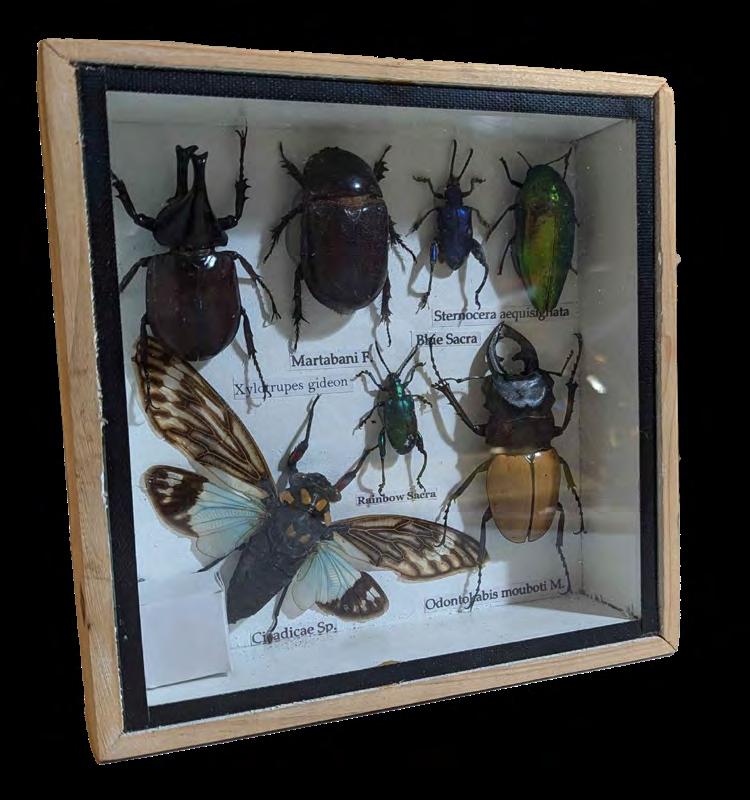
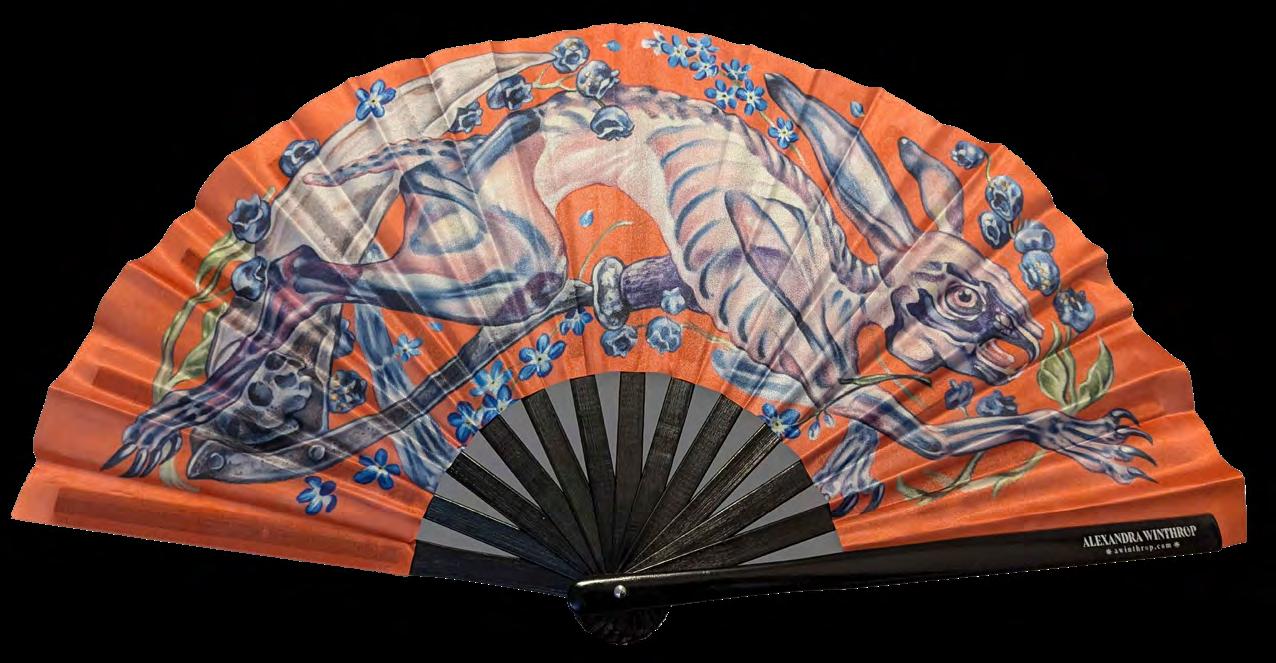

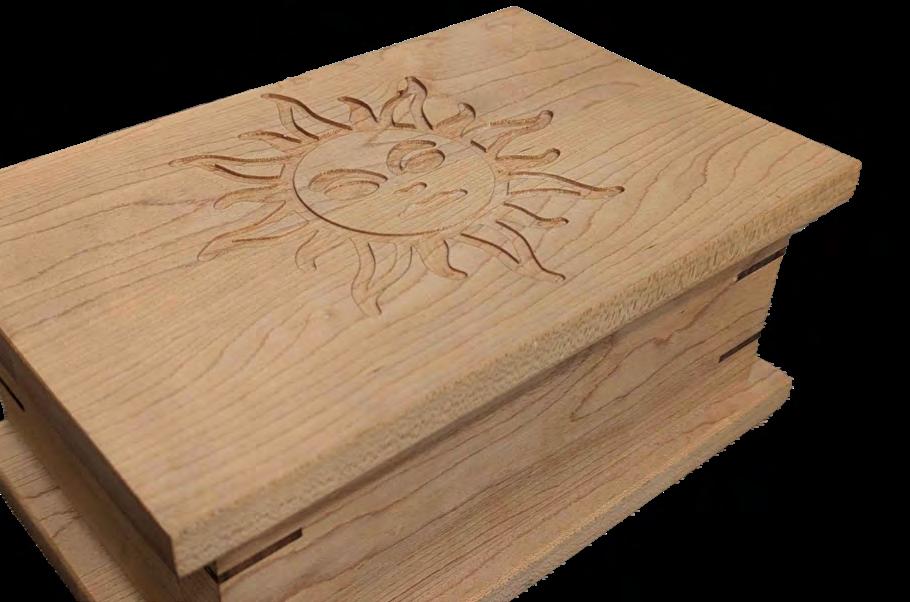


Tobin Zheng Editor-In-Chief, 2T4-2T5 some belongings of mine which I cherish & which define my style.

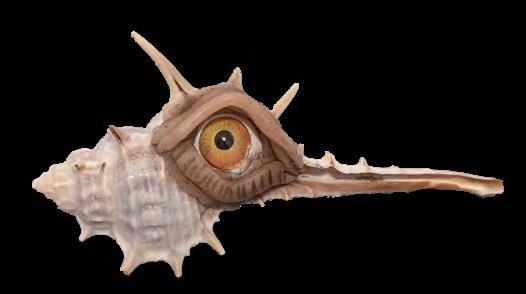
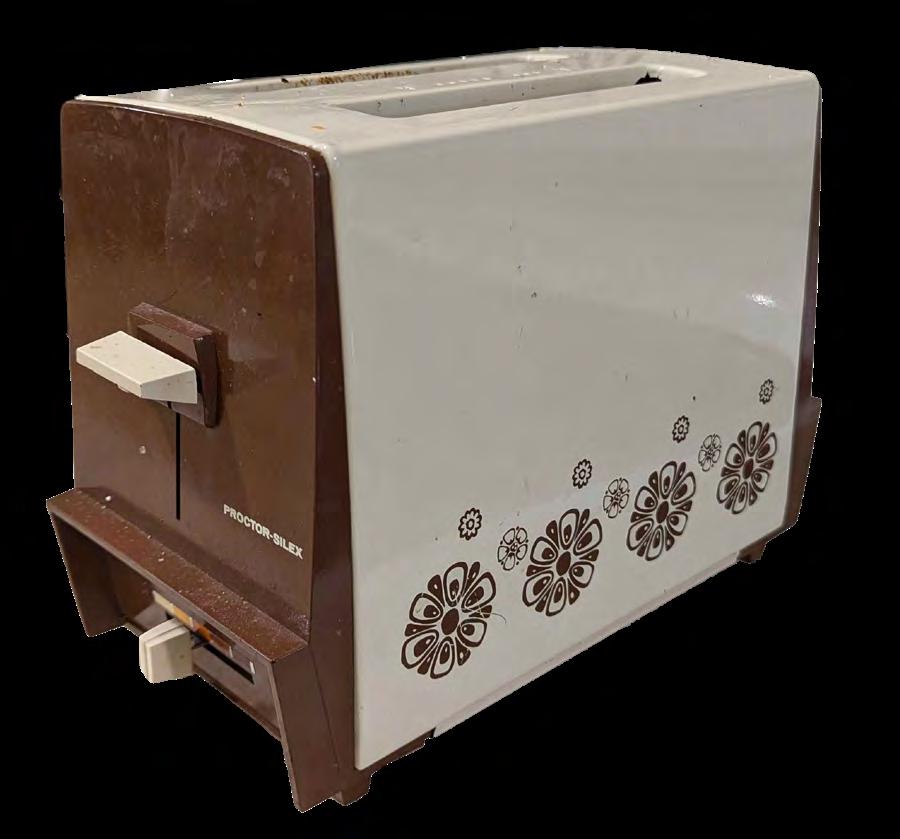


Fast Fashion: Convenient, but at what
Charlie Therence
The idea for this article came to me when I visited Vaughan Mills. As you might be familiar, Vaughan Mills houses outlet stores. Walking through the mall, I noticed massive, massive stores filled to the brim with unwanted clothes on clearance. They were on sale for 70%, or 80%, or even 80% with an additional 20% taken off—but these clothes were still unwanted. On top of that, I noticed that a lot of these clothes were made in Indonesia - because my eyes are naturally attracted to the word “Indonesia” (#Merdeka).
The first time I saw a “Made in Indonesia” tag, I chuckled and had the urge to run through the streets of Toronto with an Indonesian flag wearing a peci. But after seeing racks upon racks of unwanted clothes sporting a “Made in Indonesia” tag, I was just horrified.
Labour and Poverty
Indonesia is an archipelago in Southeast Asia, and the fourth most populous country in the world, which 280 million residents call home¹. It is also one of the world’s largest textile producers and garment exporters², becoming a common place for clothing companies to manufacture their merchandise due to the abundant workforce, cheap labour, and lack of environmental regulations. Indonesia’s textile export value reached nearly 8 billion USD in 2022³, but at the same time, this line of work is plagued by low wages and unsafe working conditions⁴. 10% of Indonesians still live under the national poverty line⁵ – comparable to well over half of Canada’s entire population.
Pollution
The Citarum River is the longest river in West Java, and is incredibly polluted with lead, mercury, and arsenic, among other toxins⁶. A significant source of these pollutants are clothing manufacturers, and toxin levels continue to increase

with growing demand for apparel. Locals still depend on this river for agriculture, bathing, and washing their clothes, tasks which are now more dangerous due to the pollution levels. Not to mention the factory workers, who come into direct contact with these toxins at work every day. I grew up in West Java. It breaks my heart to learn that the soil I was raised on is being poisoned for the benefit of clothing companies that I don’t even like. They don’t even make good clothes!
Beyond Indonesia
So far, I’ve only focused on Indonesia. But Indonesia doesn’t even scratch the top 5 when it comes to garment manufacturing. China, Bangladesh, Vietnam, and India are some of the biggest victims of fast fashion.
The fashion industry contributes 10% of global greenhouse gas emissions, making it the third-largest polluting industry. From the raw materials to manufacturing to distribution, this industry generates 1.2 billion tonnes of emissions every year⁷.
We also have to consider the fabric that is being wasted during and after production. An estimated 15% of fabric is wasted from cutting in production, and clothing items are only worn 7-10 times on average before being thrown away. Canadians throw away 500 million kilograms of fabric every year, and less than 1% of this amount gets recycled⁸. Globally, this figure isn’t much better, with an estimated 12% of waste textiles getting recycled. Additionally, washing clothes with polyester content releases half a million tonnes of microplastic every year - this is the same as 50 billion plastic bottles⁹!
Most fast fashion consumption happens in “developed” countries, like Canada, but the countries that are most affected by consumption are the same countries that are being exploited for production. A significant amount of Canadian trash ends up in countries like the Philippines or Indonesia¹⁰. Global warming is also causing temperatures to reach uninhabitable levels in already warm

what cost?
countries, such as India. Many places are becoming more and more susceptible to extreme weather events. Archipelagos, like Indonesia, are sinking for the same reason, with Jakarta sinking at an alarming rate of 1-15 cm a year¹¹.
My childhood home was near the coasts of Jakarta. Before I moved in early 2018, my from cities far away from Jakarta. It’s common for housemaids to go years without visiting their families back home. Did their families get to see them

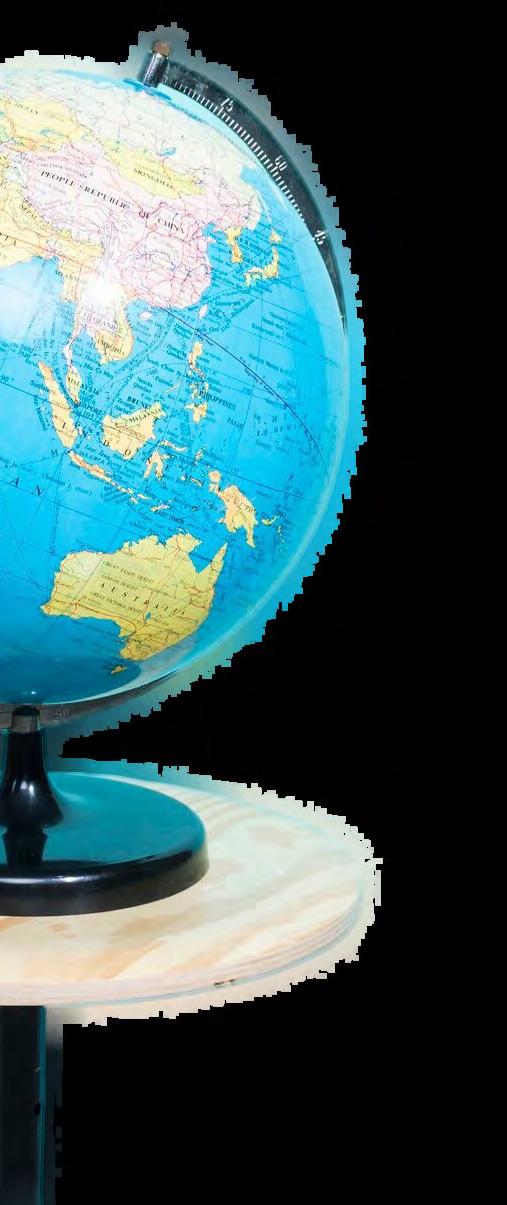
Honestly, the amount of times I have to mention Indonesia again and again is discouraging. I’m not doing it on purpose. Other countries’ trash keeps ending up there and the country happens to be extremely vulnerable to climate change. How many more people need to die before we care enough to stop buying
You might be asking: so what’s the solution here? Honestly, I’m asking that too. If I think about this too much then I just end up feeling evil for wearing clothes in general. Maybe I should just join a nudist colony. I’d love to preach deleting TikTok, but I hate sounding like an old pretentious contrarian. But still, I think there’s worth in reflecting on how our behaviour is feeding the fast fashion industry. Is the content I’m consuming just marketing? Do I really need this, or is this just a microtrend?
Basically, all I’m saying is it’s not cool to blame overconsumption on sustainable brands being too expensive or fast fashion clothes being too cute. People across the globe are being exploited for the benefit of fashion corporations, and farmers in Indonesia are already losing their livelihoods due to polluted water sources making their land unusable. Real people are being negatively affected because we can’t agree that things are wearable for more than a few months. The onus is on the industry to change their practices, but this does not excuse staying ignorant to the fact that our actions are directly contributing to the suffering of others. As consumers, we have the responsibility to practice restraint and to discourage overproduction and overconsumption.
Sources:
Sadly, I still often see selfish takes on fast fashion. “We’re all poor and can’t pay 50 dollars for jeans,” “We deserve to have clothes we want at accessible prices,” “But they’re just so cute!” These statements are selfish but they also raise a good point –except for the last one. How can I make sure I’m adequately clothed without polluting rivers in Asia? Lots of people love to preach sustainable brands and secondhand clothing, but a lot of sustainable brands aren’t accessible and secondhand clothing prices are only going up because of
1. https://web.archive.org/web/20231028112853/https://dukcapil. kemendagri.go.id/page/rea d/data-kependudukan
2. https://finance.yahoo.com/news/15-largest-textile-exportingcountries-123225641.html 3. https://www.researchandmarkets.com/ reports/5867876/indonesia-garment-manufacturin g-industry
4. https://www.fairwear.org/programmes/countries/indonesia/
5. https://www.thejakartapost.com/academia/2019/08/20/its-okay-to-bepoor-why-fighting-p overty-remains-challenging-in-indonesia.html
6. https://www.theguardian.com/global-development/2013/nov/08/toxictowns-poisoned-rive rs-byproduct-industry
7. https://earth.org/fast-fashion-pollution-and-climate-change/
8. https://globalnews.ca/news/9430446/textile-waste-fast-fashionontario-research-recylcle/ 9. https://earth.org/statistics-about-fastfashion-waste/
10. https://www.cbc.ca/news/canada/fifth-estate-recycling-1.6410657 11. https://www.bbc.com/news/world-asia-44636934
WELCOME TO THE OTHER SIDE: A Deep Dive into DPR
Iva Guo
“The world slowly turned black and white. Even the light was gradually slipping away, engulfing the world in darkness. This is where we begin our journey.”
These were ominous words heard from a robotic, female voice, in the pitch darkness of the Coca-Cola Coliseum, just moments before the DPR show began.
It was the second-to-last stop on the North American leg of DPR’s 2024 “Dream Reborn” tour. My expectations were high—I had spent a considerable amount on my ticket, then another impulsive $110 on the tour hoodie while waiting for the show to start, all justified by the fact that I’d missed their last tour in 2022 while out of the country. I had my camera on, trying to catch some of the opening theatrics just in case I wanted to refer to them in this article. But truthfully, I wanted to fully immerse myself in the experience, knowing that the creative masterminds behind DPR would bring something otherworldly.
Dream Perfect Regime: a Distinctive Audiovisual Experience
DPR (short for Dream Perfect Regime), is a multi-genre music and video collective based in Korea, with a main focus on “actualizing a distinctive audiovisual experience” for their audience. At a glance, their work seems to take a lot of influence from and follow the production patterns of K-pop, or Korean pop music; since their establishment in 2015, they’ve achieved a scale of production and recognition comparable to popular K-pop acts. Where they differ from mainstream K-pop, however, is in their self-ownership and the artists’ full control over creative endeavours.
As a large umbrella genre, K-pop has evolved drastically over the last decade and a half—now tremendously more mainstream and celebrated by Western audiences than it had

IAN’s Artistry and Style
been in the late 2000s and 2010s. In the visual department, it is known most for its flashy outfits, synchronized choreography, and highly-produced music videos. Some of us who randomly stumbled onto the Korean side of YouTube in 2012 (me) will recall the excessive colour grading, boys with questionable haircuts dancing in empty warehouses, and story-heavy music videos. Edgy and angsty plotlines were not just encouraged for these MVs, but seemingly mandatory, and arguably edgy just for the sake of being edgy. On the boy band side of K-pop, these years were marked by MVs featuring gang fights and hostage situations (“Back” by INFINITE), FBI double agent betrayals (“One Shot” by B.A.P), and gory voodoo dolls (“Voodoo Doll’” by VIXX), just to name a few.
Australian-Korean DPR member Christian Yu began his musical career in 2012 with boy band C-CLOWN, who emerged on the scene dancing in a sewage tunnel and wielding flaming skateboards. C-CLOWN was short-lived, however, promoting for only three years before disbanding in 2015. Yu then went on to establish DPR alongside several others—all of whom attached the record label’s acronym to their stage names as a prefix, hence giving rise to DPR IAN and the popular rapper DPR LIVE (Hong Dabin).
Since then, Ian has been releasing solo music primarily in English, and is behind much of DPR’s visual art. He has directed and edited music videos for his own music, his labelmates, and big names like IU and BIGBANG member Taeyang.
DPR IAN: From an Artist’s Dreams to Reality
I discovered Ian’s music in twelfth grade, when Spotify shuffle introduced me to his 2021 song “Dope Lovers,” and subsequently the album “Moodswings in This Order.” I distinctly remember this to have happened at 3 AM, while I was severely sleep deprived and working on three cumulative papers all at once (a prelude to engineering life, I guess). Funnily enough, the way I would describe Ian’s music is adjacently related to the sleepless circumstances under which I first heard about him: the feeling of a bad yet hauntingly beautiful dream you simply cannot wake up from. Something about his musical style reminds me of lucid dreams and sleep paralysis, the latter of which I had the unpleasant experience of developing towards the end of high school. I lack the technical music knowledge to put this feeling into words, but I believe it lies in his use of spacey-sounding instrumentals and musing, oftentimes incoherent lyricism.
His visual style is in the same vein, dark and grimy (“So Beautiful,” 2021), vibrant and surreal (“Peanut Butter & Tears,” 2023), and entirely nightmarish at times (“Don’t Go

Insane,” 2023). Across all of his music videos, absurdity and horror are common themes, with horror being a blend of goth, paranormal, and supernatural aesthetics.
In “No Blueberries,” three blueberries in Ian’s ice cream trigger an encounter with a blueberry monster at the Devil Diner. Comedic horror makes an appearance in “So I Danced,” when he and a green man in a cowboy hat rob a vault and are then chased out of the city by a shadowy figure (I’m not joking). In “SAINT,” a fantastical castle forms a backdrop for a fallen angel to steal a sword, sprout wings, and play music on a supernatural Launchpad that summons tornadoes and lightning (I’m still not joking).
It’s this combination of masterful VFX and imaginative stories—bordering on absurd—that results in what feels like a fever dream. Ian’s visual style and creative direction is a means for grand storytelling, meant to transport viewers to a whole other universe where they bear witness to unique and purposeful characters.
“The Other Side,” he often calls this world, which is almost MCU-esque in terms of nuance, detail, and lore. In an interview with Zach Sang, he revealed that the dark figure
reoccurring in his work is Mito, a jealous, vengeful fallen angel on a mission to hijack his maker’s other creations and make their stories his own. The 2022 release of “Moodswings In To Order” (“In To” not to be confused with the aforementioned “In This”) later introduced Mr. Insanity, an eccentric, colourful and wild character to counter Mito’s darkness.
The characters in these videos are a part of him. Quite literally. What felt much like fever dreams and escapism through the arts (to me personally, anyways, something about art being subjective) actually comes from a lived reality for the artist.
As a teenager, Ian was diagnosed with bipolar disorder; later in his twenties, he was also diagnosed with dissociative identity disorder (DID). Since leaving the K-pop scene, he has been extremely open about this, often discussing how he uses his condition for art, and how he uses art as an outlet. One of the many ways he’s channeled his condition into his work is through the immense lore and characters he’s built up: Mr. Insanity and Mito are actually personified versions of the high and low episodes of his mental disorder, respectively.
“My whole life, I battled with this, I guess, other individual, until I finally decided to make him come to life. His name’s Mito.”
—DPR IAN in “Memories in Disorder,” Official ‘MITO’
Documentary
Ian chose to give Mito power, persona, and story because Mito, or his low points, has been behind much of his work; he’s giving credit where due, in a sense. His songs “So Beautiful” and “Nerves,” for example, both came out of a depressive state, and ended up being “more impactful” works that his audience gravitated more towards. Although in the same interview, he explained that it feels like he’s “abusing” his condition—that he’s using phases of extreme emotion to fuel his work, a process that is more detrimental than it sounds, which practically “zapped the life force out of [him]” during preparations for his second album.
In the same way that this chaotic process brings about outstanding work but at his personal expense, it feels like creativity is both a blessing and curse for him. It’s a sentiment I can relate to, as someone with too many creative hobbies but very little time for them (school is to blame, obviously). The wilder our imagination, the more our ambition grows to bring that imagination to life—the more we strive to fill in the gaps between the current reality and what could be.
“I sometimes wonder if that [creativity] did me more harm than good. Because you’ve just shown me a world where you can absolutely do anything you want with the feelings that you have. I, from that point, just ran with it… it [his work] started getting bigger and bigger.”
He also attributes this outburst of “bigger and bigger” creative work to the lack of control he experienced as a K-pop idol,

and the subsequent freedom he experienced after C-CLOWN disbanded. It’s no secret, especially in recent years, that many Korean pop stars have their music, style, and even on-stage personalities prescribed to them by their companies. Former stars including Ian have testified to feeling like “dolls” while in the industry, with little say over their work, driven in whichever direction the record label believes will rack in the most profit.
Ultimately, I believe this is what makes DPR so appealing to both K-pop fans and the wider worldwide audience: the impressive spectacles Korean pop music is known for, but backed by the artists’ genuine passion and interest in their own work. This isn’t to say that K-pop is any less impactful or spectacular simply because it’s often more manufactured— but it’s certainly refreshing and inspiring to see artists like the DPR collective acting independently, standing firmly behind their work, and succeeding on a global level.
The Dream Reborn World Tour: a Brief Review
After securing tickets to the DPR “Dream Reborn” tour stop in Toronto, I was excited to see what visuals Ian and the rest of the crew (Cream and Artic) would be bringing with them. I knew they would likely follow the format of a K-pop concert, simply considering Ian’s direction with his visual media,
alongside all the previously discussed. If you’re unfamiliar with K-pop concerts, they tend to be an extension of the overthe-top coordination and extravagance the genre is known for to begin with: including things like multiple wardrobe changes, cinematic videos for the audience to watch during said wardrobe changes, even overarching narratives and drama like what ATEEZ presented in their recent “Towards the Light” world tour.
DPR did not disappoint.
The entire concert was presented as a journey through space and time, led by an ominous, AI-resembling character who appeared on the big screen every so often to narrate. Artic and Cream opened with a DJ set each, both accompanied by colourful visualizers reminiscent of 2010s EDM, and a copious amount of fog spilling off the stage. The screen was truly never blank throughout the concert—a constant backdrop of purposeful video, and while I don’t doubt that some of it was stock footage for budget’s sake, they added tremendously to the atmosphere.
Then we arrived on The Other Side, where we finally met Ian and his cast of characters.
My boss, who I briefly mentioned the concert to, had been quick to search them up and point out that Ian looks like a guy “girls would go crazy for”. He was right. I think it goes without saying that I lost a bit of my hearing from the screams around me. Though this isn’t to say that I didn’t pop a Halls the next morning too.
But when Ian calls his audience members “love” and “darling” in his smooth Australian accent at any given opportunity, can you really blame them?
All of that aside, I was in constant awe of the entire production. The level of detail and care that had gone into it was unfathomable. Almost every song Ian played had been rearranged for a live band, with a different energy but the original emotions fans know and love. The Green in the cowboy hat was in attendance as a smooth, groovy backup dancer for “So I Danced.” At some point, Ian appeared as Mito, wearing (and then shedding) the same black wings we’ve seen in so many of his music videos.
Arguably, many of Ian’s music videos don’t do his choreography as much justice as his live performances. His current style of dance differs from that of his days in C-CLOWN: focused on execution and feeling as opposed to complexity, performed in an over-exaggerated and campy manner at times. What might appear to be simple and repetitive movements are actually textured and full of character, with a comedic, playful feel that’s easy to groove along to as an audience member. I spotted mostly jazz, contemporary, even tango influence; and a blending of movements traditionally considered masculine or feminine performed by all of his backup dancers regardless of gender identity.
When it came time to close out the night, Ian promised that DPR would come back to Toronto soon. And while I know this is an obligatory promise that all performing artists make to their fans—one often disrupted by factors outside of their control—I rest assured knowing that DPR care tremendously for their work and will continue to cultivate a global audience, both of which will hopefully see them performing and touring for years to come.
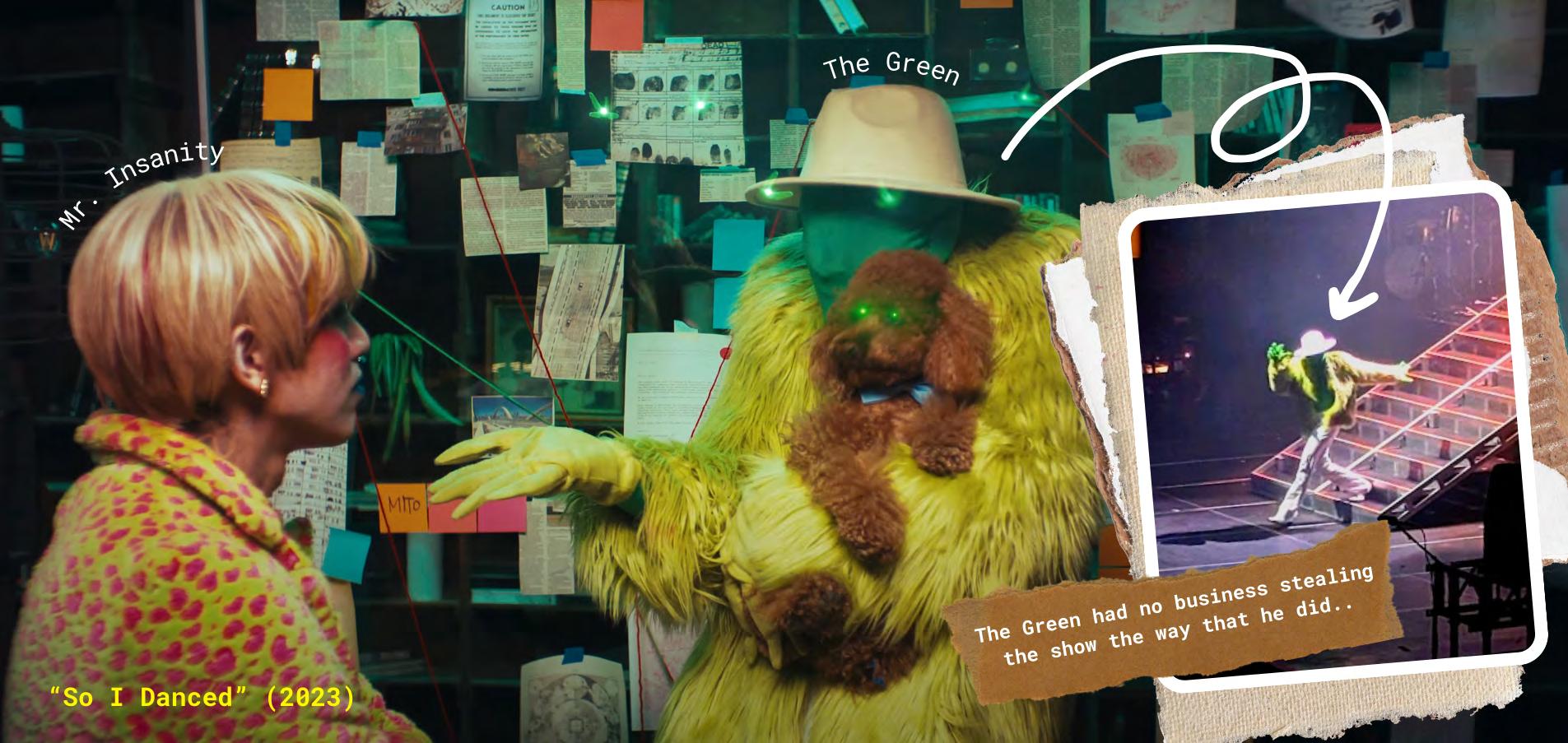
‘We never go out of style’ (or do we…)
Christina Pizzonia
While revisiting films, photographs and TV series of the past, I think we’ve all looked at certain outfits (ranging from slightly dated to downright outlandish) and immediately thought, what on Earth were they thinking?!?! With that in mind, fashion–like much of human history–is cyclical, and as modern-day life changes rapidly with technology, many of us find ourselves yearning for the nostalgia of the past. Join us as we explore some monumental trends from the ’80s up until the 2000s, and decide for yourself whether these trends should have stayed buried in the past or if they’re poised for a well-deserved comeback!
Scrunchies
Frustrated with the damage caused by plastic hair bands, Rommy Hunt Revson—inspired by the comforting fit of sweatpants—created the first “scrunci” (later scrunchie) by wrapping a thin sheet of fabric around the waistband of some old pyjamas. Scrunchies soared in popularity in the 80s and 90s, popularized by female singers and actresses such as Madonna, Janet Jackson, and Sarah
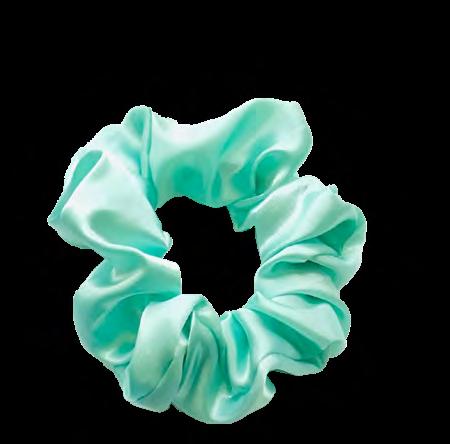

lower leg became more popular. This came to a head with the “Mom Jeans” SNL skit in 2003, which ridiculed the jeans and sent them further into the realm of ‘uncoolness’.
Nowadays, women and girls are taking back the ‘mom-jean’ label, while bootcut and skinny jeans fade into mild obscurity (on a personal note, I am still a fan of skinny jeans - even though my so-called “fashion forward” friends maintain that they should never be worn in public again).
Crocs
Hate them or love them, Crocs are one of the most recognizable brands of footwear for millennials and Gen Z, having first debuted in 2002 as a plastic “clog”, built for land and water use from a proprietary cell resin. By 2006, sales had ballooned, and it seemed as if Crocs were here to stay. But consumer panic about the potential health impacts of using Crocs coupled with their simplistic design hit the company hard, and by 2018, Crocs had announced the closure of 160 of its retail stores.
An eclectic mix of nostalgia, comfort, and sustainability, scrunchies have been making a comeback in the present, with singers Selena Gomez, Ariana Grande, and Lizzo all having been seen sporting them. Even the notorious RBG adored scrunchies before her passing, though, of course, one might argue that her love affair with scrunchies predated their modern-day comeback, having worn them as far back as 1993 when she wore a blue scrunchie while taking her oath to become a Supreme Court Justice.
Mom jeans
Characterized by a high waist, straight legs and use of non-stretchy denim, “mom jeans” were commonly worn by women in the 70s, 80s and 90s, and rose to notoriety following Brooke Shields’ Nothing gets between me and my Calvins ad campaign. Perhaps unfortunately, by the late 1990s, the term became synonymous with “outdated” as tight, low-waisted jeans that flared in the

Fortunately (or perhaps unfortunately, depending on your stance), a new CFO and target marketing campaign led to their resurgence—and while some might still find the look of Crocs to be “unaesthetic” or “childish”, many have come to revere them once again for their comfort, customizability and overall durability. Even Post Malone and Justin Bieber have hopped on the “Crocs train,” having come out with their own designs available for purchase.

Honourable mention: Bucket hats
Bucket hats are the oldest article of clothing on this list, having made their first debut in the 1900s on the heads of Irish farmers and fishermen looking for protection against the rain. In the 60s, women co-opted the hat as a fashion item, and it became even more popular with rappers and as streetwear in the 80s and 90s. Although bucket hats have fallen out of popularity with the general public, there is one that remains: the mighty Skule bucket hat, worn by all well-dressed, distinguished engineers.

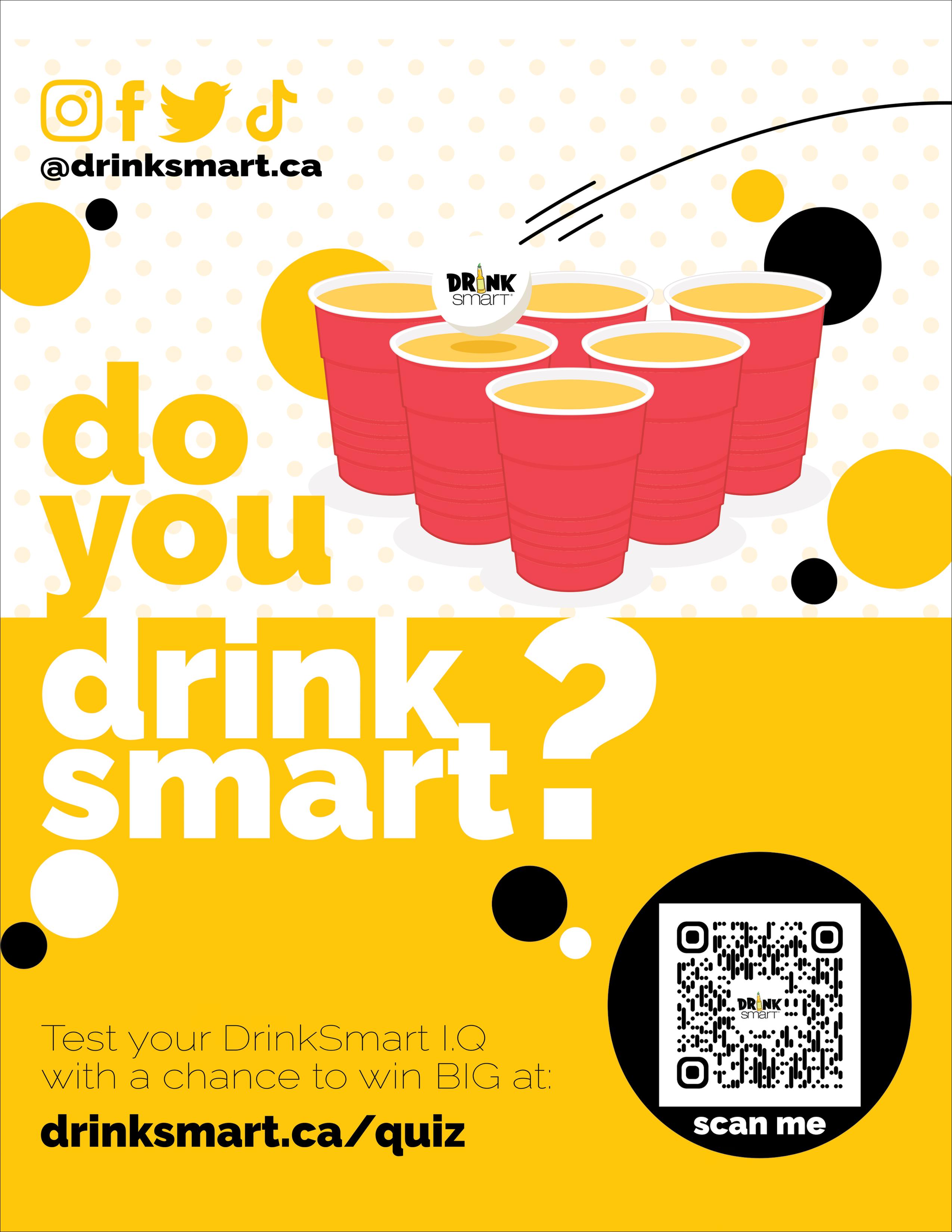
Defining My Personal Style
Navin Vanderwert
Figuring out how to style myself—and what that even meant— used to take quite a bit of time and thought. I can’t remember when or why I started to be conscious of it, but at first it was very superficial: Find things that you think others think are “stylish” and wear them—Pretty simple.
As I got more comfortable with self-expression through my appearance, I felt that none of what I was expressing was personal or interesting. I noticed that I was more comfortable and confident when I was using pieces that had lore, things that I resonated with on a deeper level than their appearance. This resulted in buying fewer things, finding new ways to use what I already had, and a lot less decision paralysis getting ready in the morning. Here’s the story of a few of my favourites
Backpack
Trying to pick an everyday bag that balances function and form can be incredibly overwhelming, so I was relieved when I found this old MEC backpack that my mom used when she was in university in the 90s.
It’s a gorgeous deep red, with a perfect balance of large, empty compartments and organized space for school supplies. The whole thing is built like a tank, and it feels like it magically changes size to the exact minimum required to carry whatever I need. More importantly, I think it makes my mom proud to see me using it like she did, and it reminds me that she’s
always got my back (pun intended). As a final bonus, it still reads MECoop, so there’s a touch of Canadian pride anytime I travel with it.
Dog tag
It’s equally important to style for yourself as it is for others, and I find little bits of symbolism a great way to do this. This is my childhood dog Maya’s old ID tag, and I’ve been wearing it on my keys since she passed away a couple of years ago. I make sure to spin it so that the tag is facing outward, and it always makes me feel her strong, calming, and trusting presence. It’s a little piece of my childhood and my friend that’s with me no matter what I’m wearing—a good luck charm to anchor me and to face the world with.

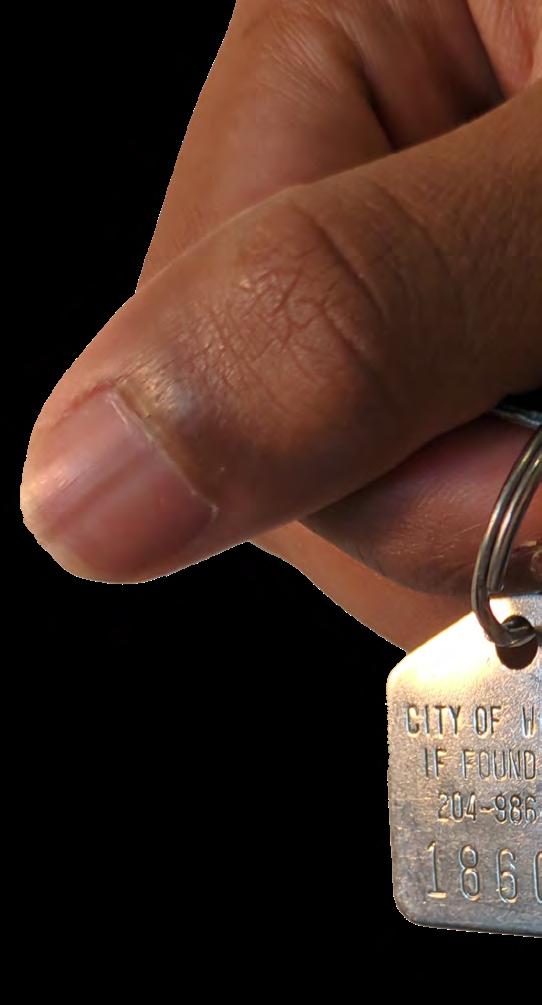
Birkenstocks
When I showed up to high school with these in 2018, I received endless taunting from friends over my “leather Crocs”. My grandma had always worn a pair of Birkenstock
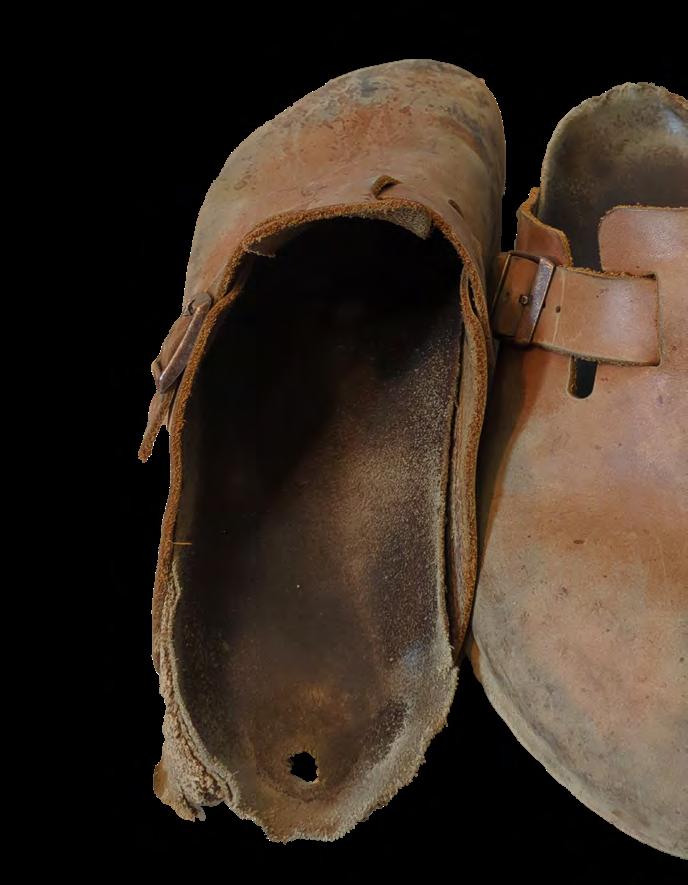
appreciate the texture and sheen the leather took on as they wore in. So when she gave me some birthday money that year, I thought I’d get myself a pair and spent some time looking into the different styles they had. I found a Reddit post from someone styling the Bostons with linen pants and thought they looked super cool. (I also got linen pants, but never really took a liking to them).
Fast forward a few years, and they’ve taken a beating. Water stains, mud stains, beer stains, and even hot dog juice straight out of the bag. One sole has a burn mark across it from resting my feet on a campfire, and both insoles
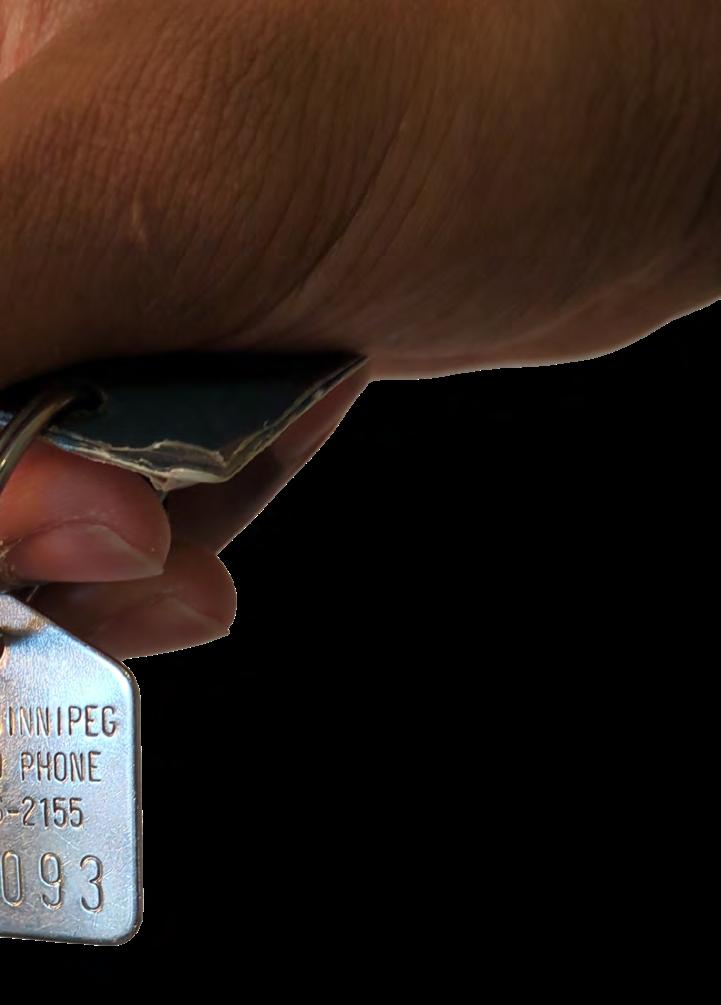
(outsoles?) are worn entirely through. My only regret is not getting them re-soled before it was too late, but I think they’ve got quite a bit of life left in ‘em if I’m okay with my heel occasionally hitting the ground.
The best part? Having my friend come back to me and admit that I was “way ahead on those.” Incredibly
Dad[‘s] Jeans
Stole these from my dad. Only pair of jeans I own, and I can’t imagine what could ever change that. I have no idea where they’re from or what size, fit, or what type of denim they are, and all of those things scare me from ever looking for another pair.

They just seem like the type of clothing that has to be adopted. Coping with the weird sizing and stretching and all that feels like a part of the experience, and I’m not sure I
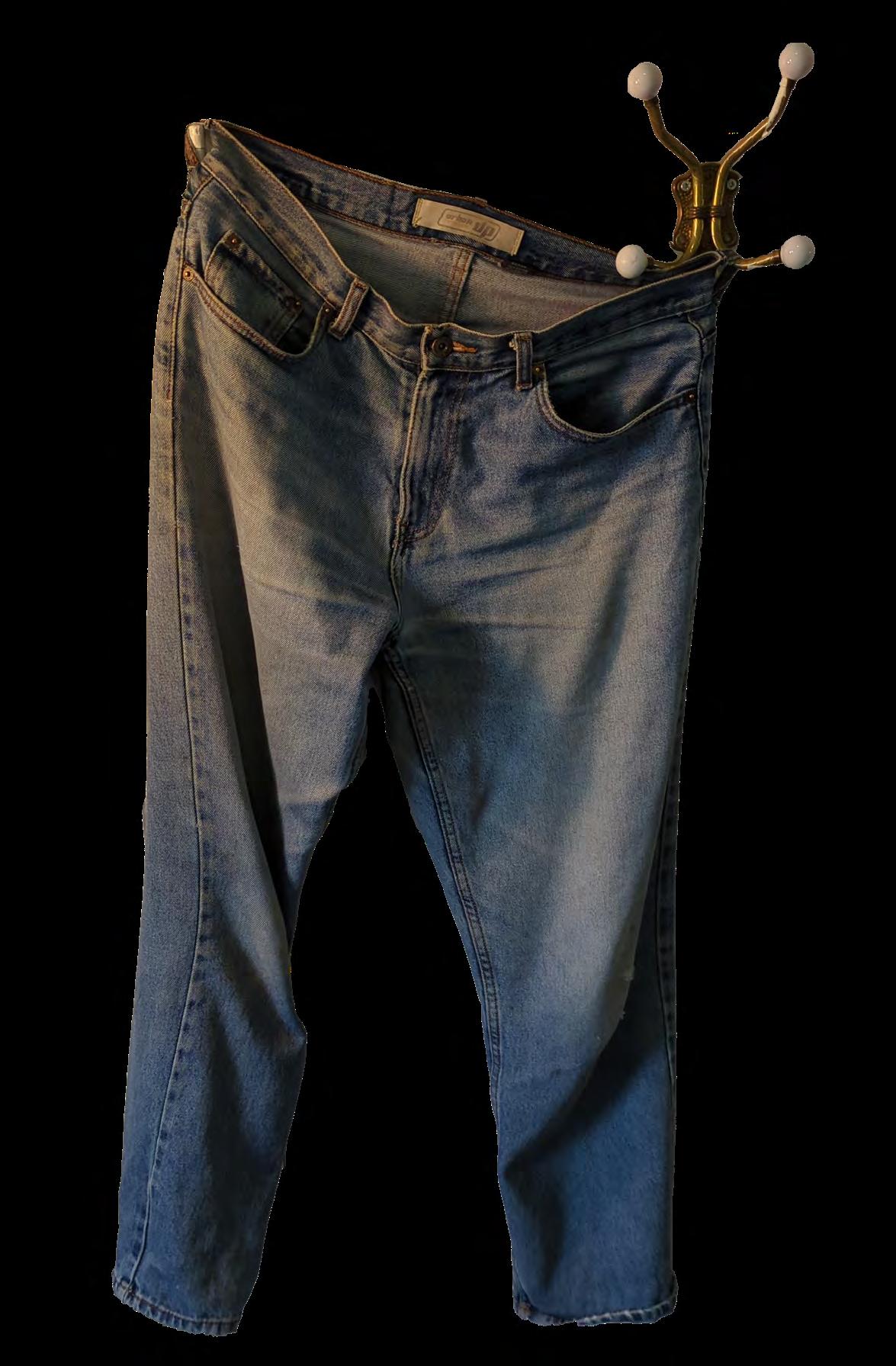

NYC Acid Plaid (Firecracker)
This one’s aesthetic. No lore, I just bought it and it looks cool. Sometimes that’s okay.
It’s made of a weighty and loose cotton weave that gives it a crazy drape and fit that I’ve never seen in any other shirt. I’m not one to baby my possessions—I strongly believe that they’re only as valuable as the use you get out of them—but this may be the one exception. It gets one of my three wooden hangers, gets washed in a garment bag, and was hung up on the wall for the first few weeks after I got it.
That’s not to say I don’t use it - on a trip last summer, I spent a day walking with my camera slung around my back and pulled out a tangled mess of thread on the lower right of the back. But, after each use, it definitely gets more care than anything else I own. If it falls apart before my future kid rediscovers it, I’ll be crushed.
P.S. - if you ever want one of these, hold out for the end of season sale.
An Exploration of Colour
Arshia Singh
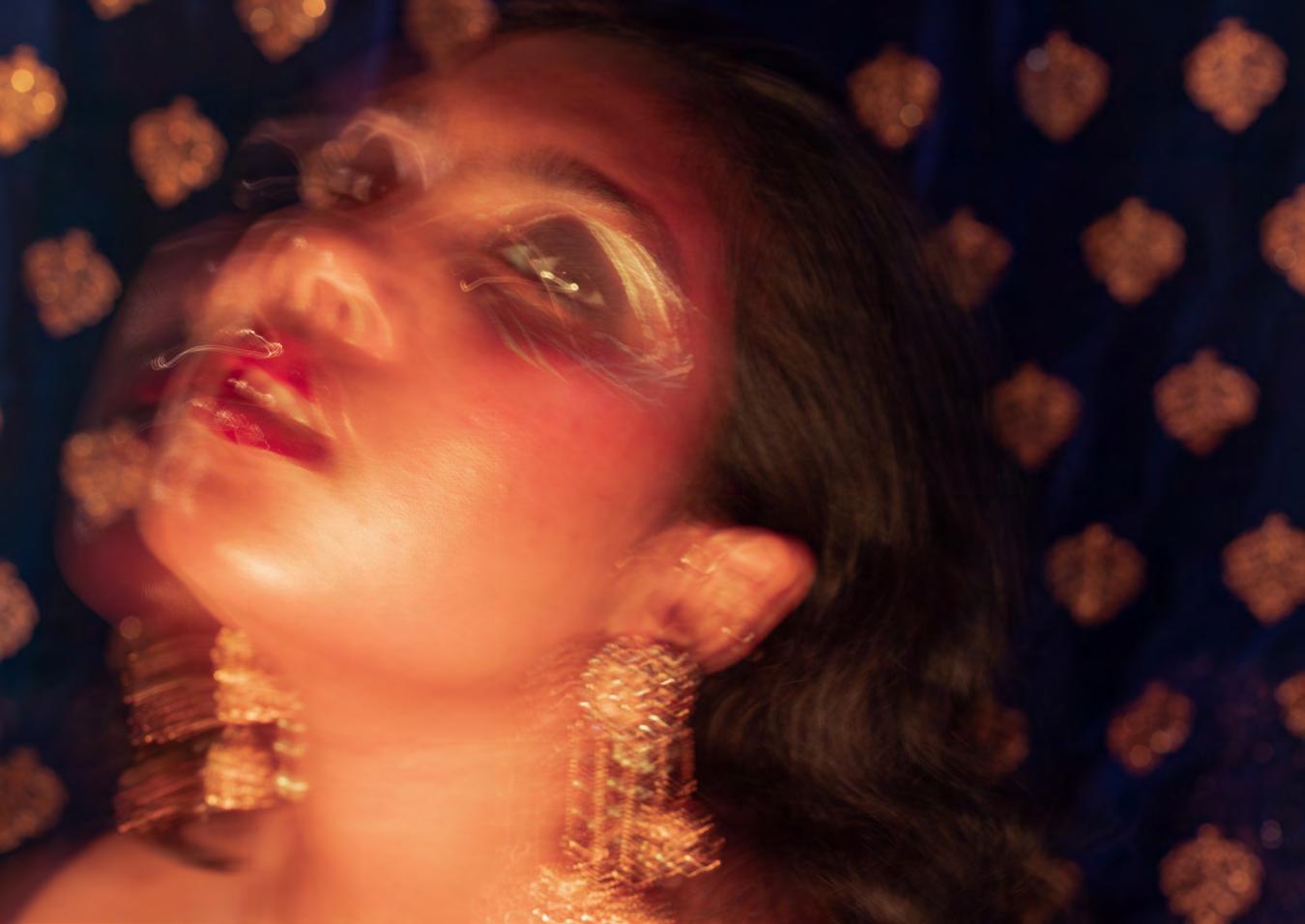

“All of my self-portraits have been in the name of exploring my style of photography. This series was about the use of colour and motion in photography and how they affect the overall composition.”

A selectiOn Of Art & POetrY

“Over the summer, my friends and I decided to work on a visual novel project to be named “The Millennium Archives”. It tells the story of a time traveller experiencing regular stories of the past from cultures around the world. Throughout the process of writing and designing the characters and their stories, the hairstyles and fashions of different eras and places were interesting to learn and made them feel more real. It’s not glamourized or idealized like in the movies, but real, regular people and their clothes. The fashions of many major characters are depicted in these sketches along with my blood sweat and tears from Summer 2024.”
- Jenn Xu
11.17.23
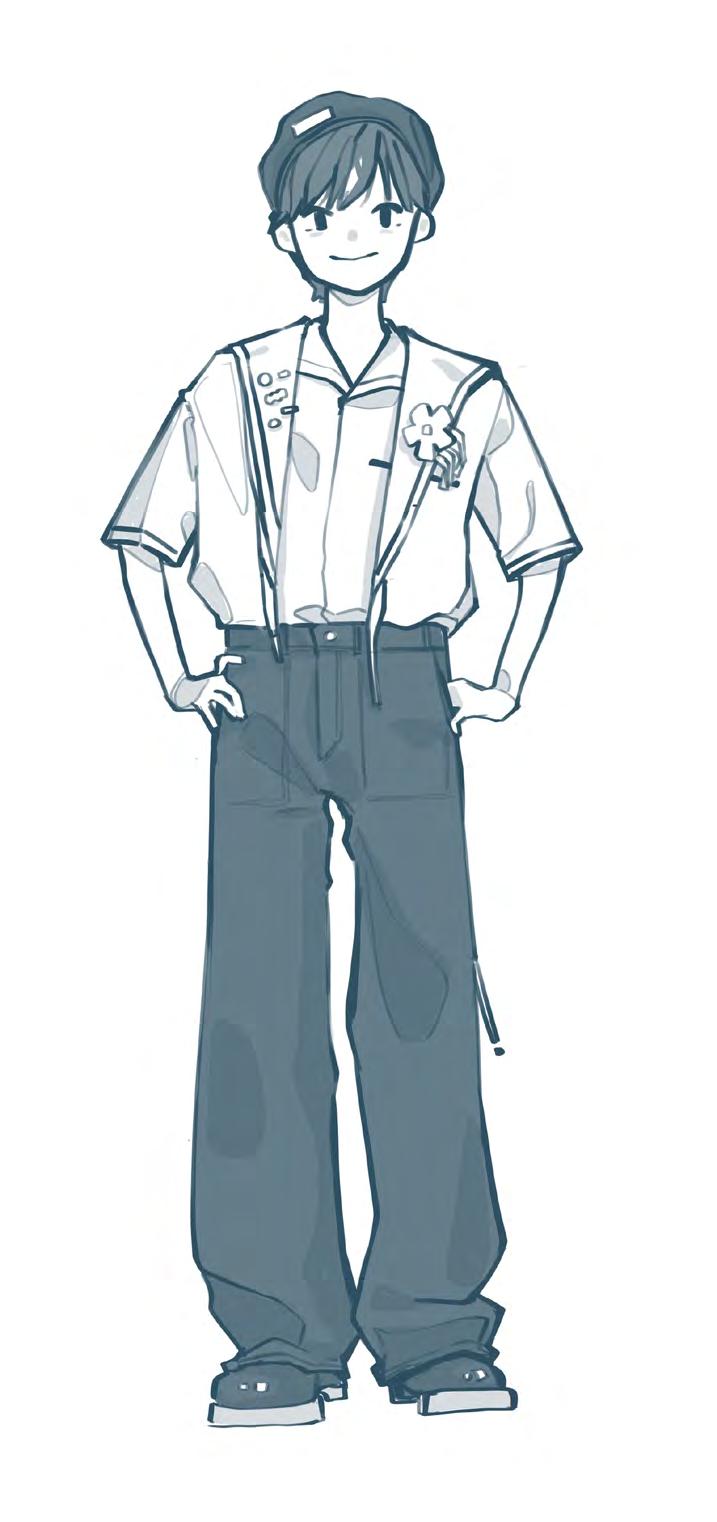
Ode tO JOrts
I think that we should all wear denim It’s a nice thing to see men in When I see some guys in jorts
I’m like, nice! Those aren’t shorts
People are so mean to me
When my pants go past my knee
But when I’m feeling down and blue I cut some jeans, and there is you!
So thank you jorts for everything
And we’ll all wear you through the spring! Lots of love from all us girls
And also men, who look like girls

MOveMent
Serving tomorrow’s icons Taking strides in expression Yesterday has been outgrown Leaving a mark beyond that of tangibility Everyone in tandem with this beauty
Natalie Chan
Late night sketching.
J Graves (Anonymous)
Alexis Kuri Garcia
Coveralls: The Engineer’s Style
Tobin Zheng
At engineering events across Ontario, whether it be orientations, spirit weeks, conferences or competitions, you’ll encounter swaths of people proudly wearing a single piece of clothing from the neck down, bearing symbols of their program and time in university. Coveralls are a wearable representation of ourselves as engineers, and so many schools have this tradition– but how did they become such a ubiquitous phenomenon?
Swedish Origins
When researching for this article, I discovered that coveralls had a much more extensive history in Sweden than in Canada. I had the opportunity to speak with Mattias Jansson, who attended Stockholm University and the KTH Royal Institute of Technology between 1992-2002. The history of coveralls dates back to the early 20th century. Swedish students would wear a tailcoat, known as a frack, to dinners and parties. Eventually, they started decorating them with various patches, and they would have two fracks, the undecorated A-frack for fancier events and the patch-covered B-frack for parties.

The B-frack is still used in some Swedish universities.
(Wikimedia Commons)
In the 1960s, the worldwide cultural shift towards the left encouraged a group of physics students from the KTH Royal Institute of Technology to adopt full-body worker’s coveralls, simply called overall, in place of the B-frack to represent their allyship with the labour movement. Eventually,
more groups at KTH began to switch to coveralls, as their full-body coverage provided more protection to clothing at parties. In the 1980’s, this spread to other engineering schools across Sweden, and even to Finland as well. Other programs also began adopting coveralls, but they remained the most common among engineering and technical programs. Different colours were used to represent people in different programs, but colours were not consistent across schools. Additionally, some students in particular positions had their own colours to identify them, similarly to how we use hardhats at Skule.
This pair of coveralls belonged to Mattias Jansson when he studied at Stockholm University. Empty circles where patches used to lie show a difference in patch trading culture—students often traded directly off of their coveralls.



Students in Finland wearing coveralls. (Catarina Stewen)
Coveralls also serve a somewhat different purpose in Sweden. Although they are worn at orientation events, most people know the overall as a party suit. Parties are the place where patches and coverall parts usually get traded. Meanwhile in Canada, trading typically happens at conferences and competitions where we interact with students from different

Coveralls in Canada
It’s unclear whether we adopted the coverall tradition from Sweden or if it started in Canada independently. The earliest appearance of coveralls in Canada seems to be at McMaster University in 1985, when their engineering Orientation Chair, Mark Huttram, purchased bright red coveralls (known there as “Redsuits”) to identify their orientation group leaders (what would be Head Leedurs here at Skule).

Coveralls at Skule

McMaster engineering students in their iconic redsuits.
(McMaster University)
reaching Skule by the late 80s. For most of the 90s, we wore coveralls with minimal decoraton - but patch-decorated covvies became more common at the turn of the millennium.
One thing that fascinates me about coveralls is the difference in decoration culture across schools in Ontario. At U of T, most students paint or sew their discipline to their right leg and year to their left, a tradition that popped up a little over a decade ago. It’s also common to see students with large sections decorated with paint. At TMU, students are not allowed to paint them, but their iconic airplane belt identifies the first year they became a Frosh leader. McMaster, which only awards redsuits to orientation leaders after an audition process, typically has students paint their two engineering programs on each leg. The back pockets are
The way coveralls are decorated at Skule is as diverse as the people in it. During F!rosh Week, I interviewed some members of the community on how they chose to decorate theirs. While the discipline and year combination remains standard for most, some students, like Matthew Doan (Mech 2T6) have chosen to take a different direction. “My plan is to draw every single sports team logo for every team on the top level of American college football,” he says, “I’m just doing this because I can.” Many students also paint their coveralls with things that represent themfrom national flags to pictograms of their interests to symbols of their engineering discipline. Other students go to lengths to make their coveralls stand out - such as Stephen Kempe (EngSci 2T5), who bleached and dyed his coveralls bright red to be identifiable as a Skule Patroller whenever he wears them.

Archives)

“I initially tried to paint the leg but I did a very awful job at SUDS so I was like how do I fix this? ... so I made strips that signify different parts of my personality.”
- Stephen, EngSci 2T5
A bnad leedur breakdancing in coveralls, circa 1999 (Skule
Many people also add functionality to their coveralls, such as Ben Boyd (EngSci 2T6), who added belt loops for carabiners, “This was so useful

AM. We [Alya and I] were both doing them at the same time and we got no sleep. We tried to sew like 20 patches in one night and then woke up for Frosh in the morning.”
- Ben, EngSci 2T6
At Skule, our iconic
available to anybody once they approach the end of their first year. I think it’s wonderful that any member of our community has the opportunity to create a unique piece of clothing that embodies their identity. “It’s like a walking advertisement of who you are,” says Stephen. A lot of students also shared sentiments regarding the importance of coveralls in our community. “It makes people feel like they belong—it unites a larger group of people who might not have ever spoken to each other,” says Ben Gloade (EngSci 2T4). Mitchell Park (Mech 2T7) says, “They feel like a symbol that I’m a part of the community. It assures me that I’m a part of this community. Even when school’s getting me down, I’m like, I still have a community of friends around me who will support me.”
“I just really like clown stuff for some reason, so I kinda wanted to look like the circus. And then of course, can’t forget to mention brat ankle. Other than that, I kind of just filled it with all my interests that make
- Alya, Mech 2T6
The ability for coveralls to foster social connection makes them a uniquely powerful piece of clothing. The traditions we have surrounding them allow them to serve not only as a medium for unique personal expression, but also as a shared symbol of our community, and I really think that’s
“ I’ve got the flag of Egypt and the flag of UAE because I’m Egyptian but I lived in the UAE for most of my life.”
- Youssef, EngSci 2T6

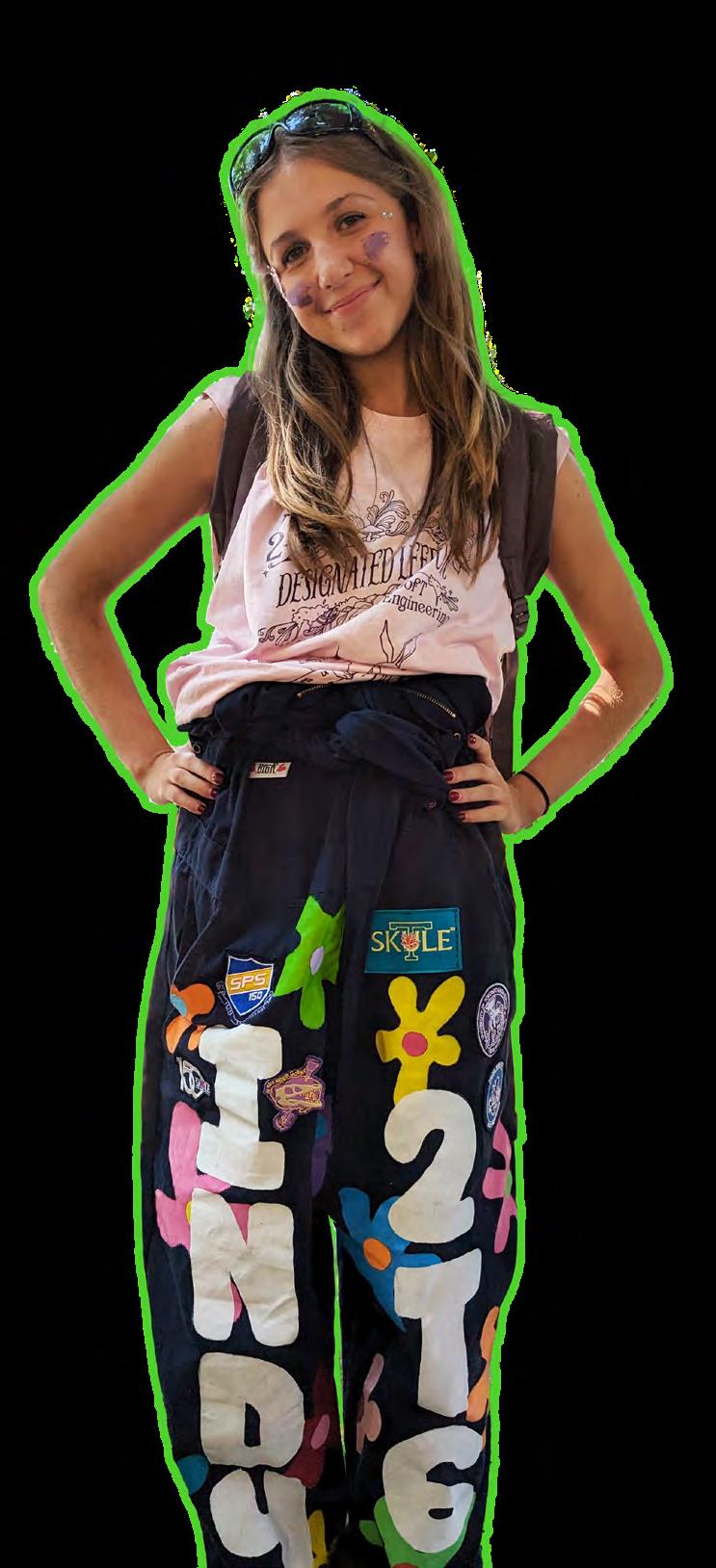
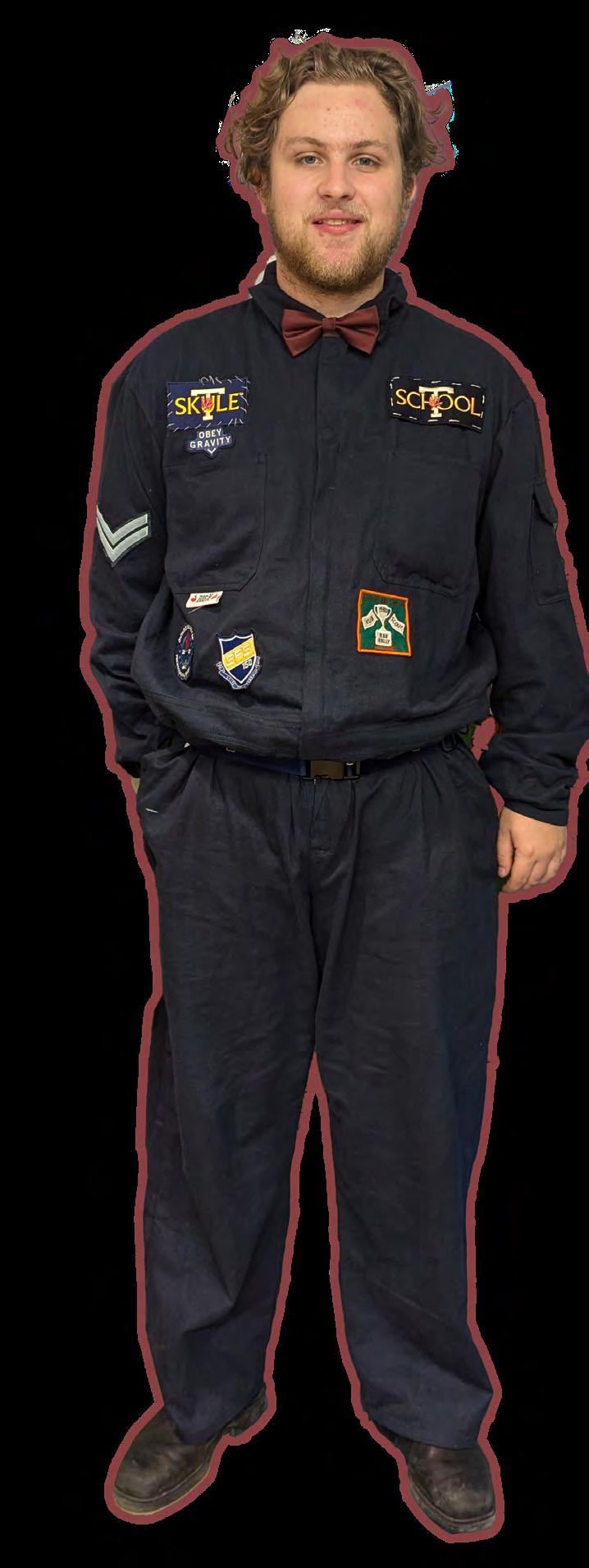
“I just got a stencil laser cut and then I painted over it to make these letters.”
- Kai, Mech 2T6
“I didn’t really have a plan going into it, I just wanted it to be bright and colourful, and like, almost like girly, because like eng women slay. So I was on Pinterest and I saw this flower design and I was like, wait I could make it sorta SpongeBob.”
- Maja, Indy 2T6

“I don’t have many patches on them yet, because I haven’t been here for that long... On my right leg I’ve just got university patches, so I



Coveralls of

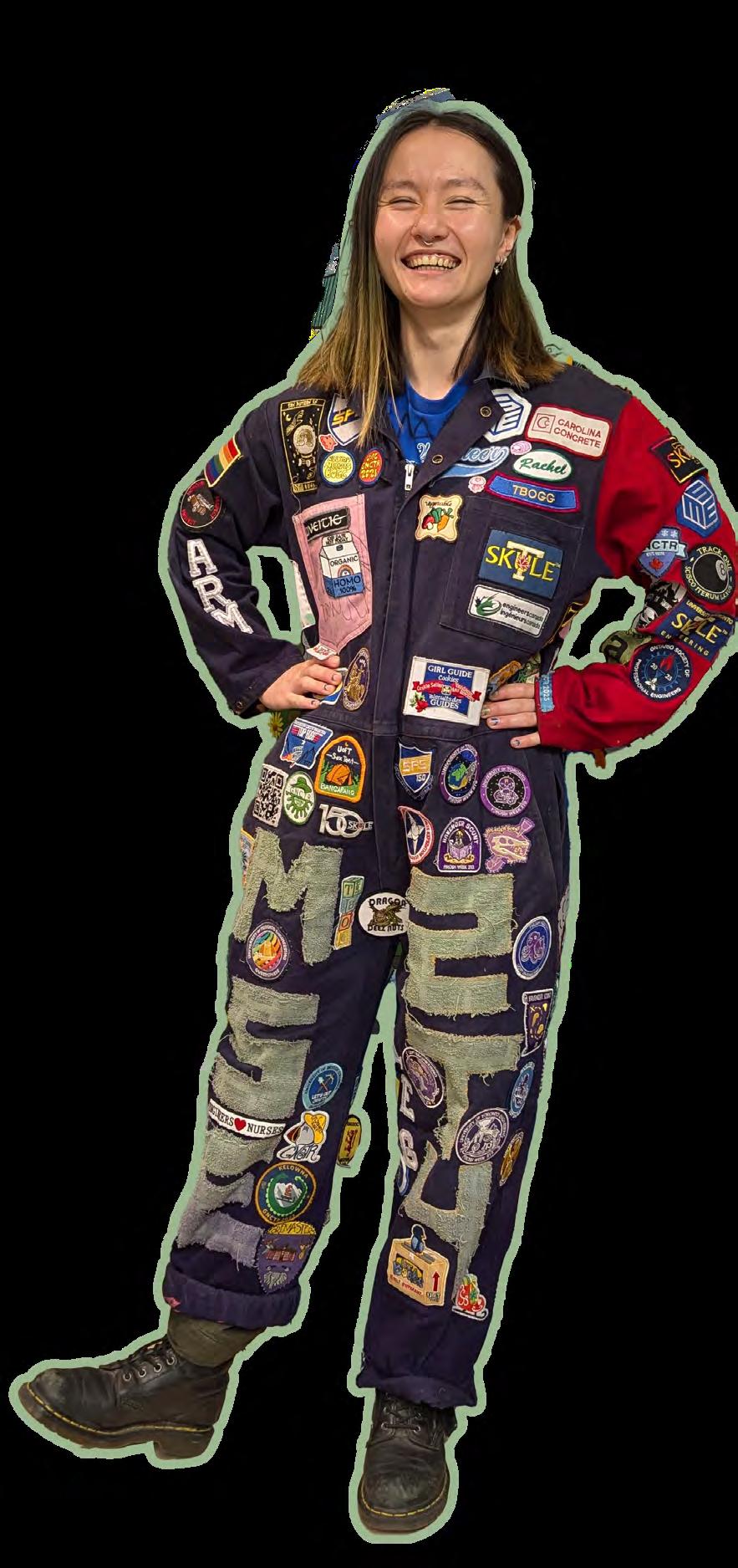
“I used towels because I wanted to be original. They started fraying a little bit but they don’t look green anymore because they went in the purple dye.”
- Raysa, MSE 2T4
“I’ve got this nice Skule belt on them and I have a bunch of different patches I traded mostly at Tbog. It’s a good fun time. I have some patches from Ontario parks and I added a fun little floral fabric to the pockets and stuff for fun contrast and I painted all the hems pink and also the Skule
saw a funny tweet and it was ‘You’re an engineer? Name every engine.’ That was funny, so I threw that on.”
- Annam, Mech 2T4
“I’m a Chem so then the letters of Chem are supposed to be like elements, I have to add the numbers still. The 2T6 is in like, organic molecules so like hexagons and stuff.”
- Khushi, Chem 2T6

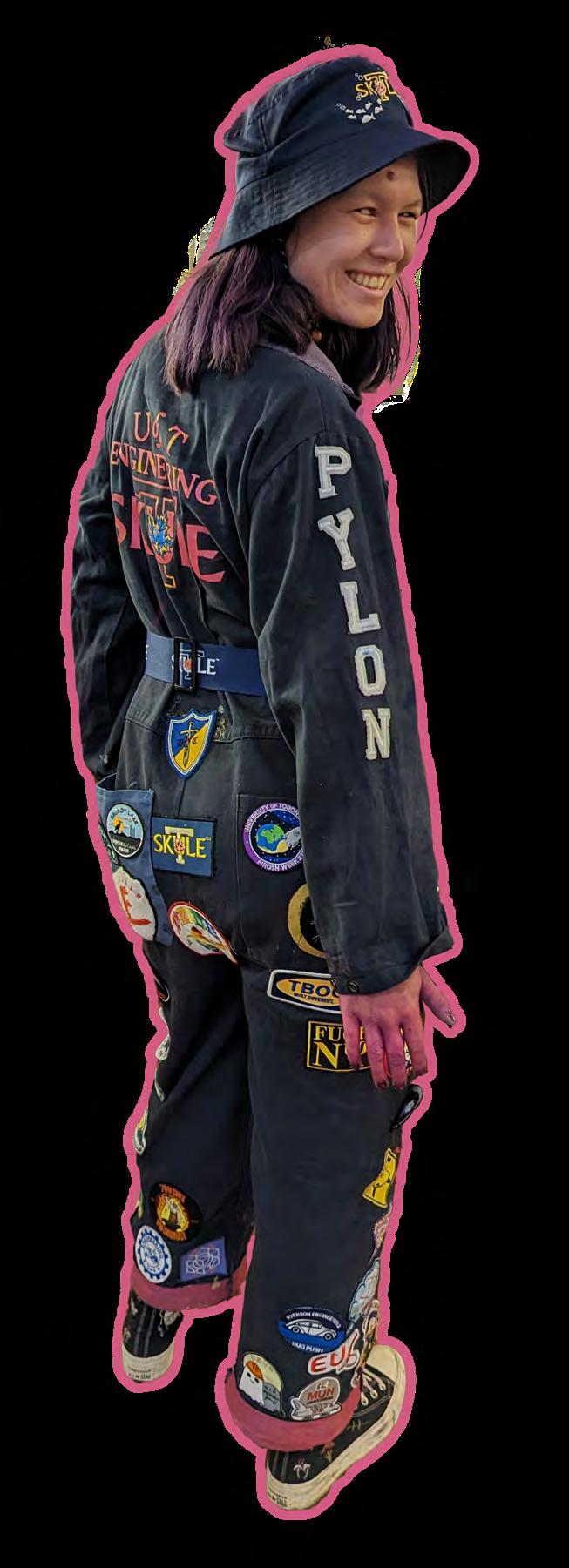

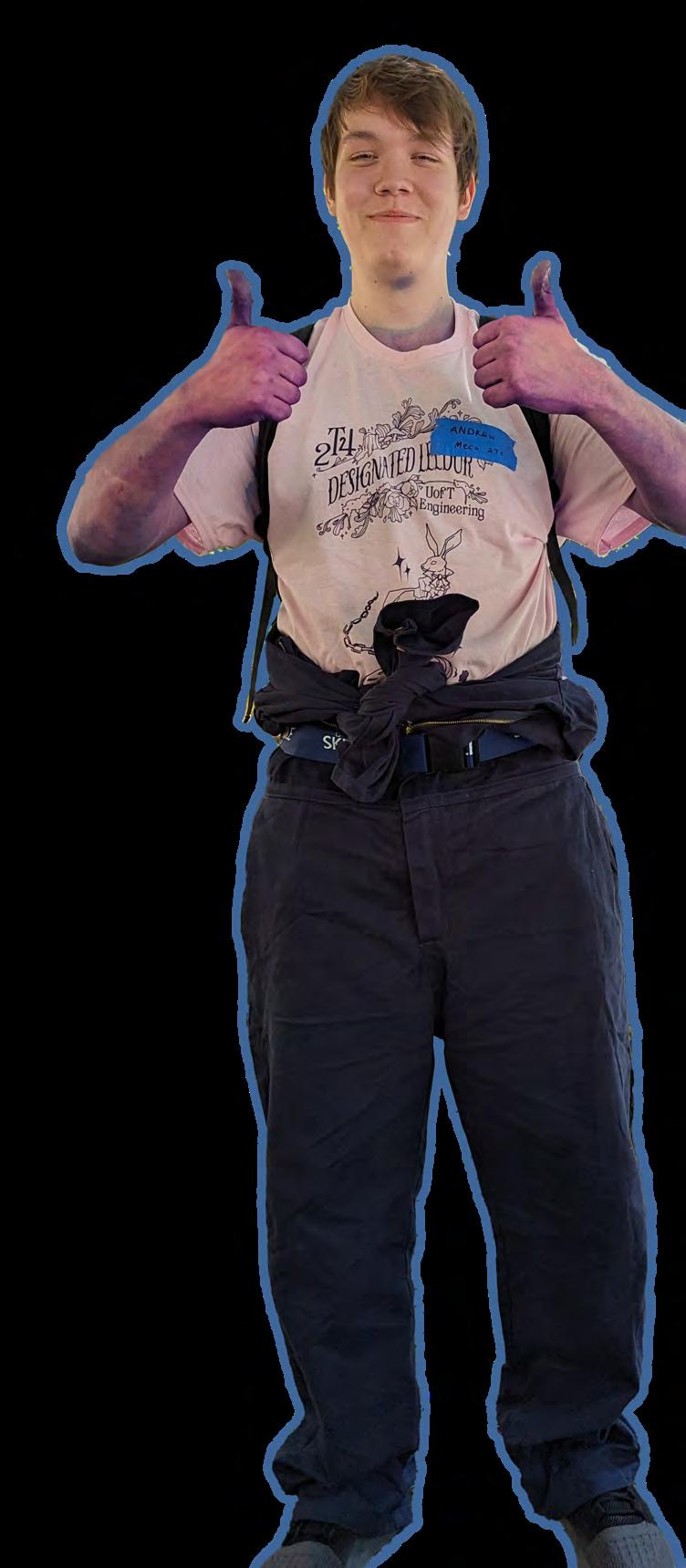
An Engineer’s Guide to a Functional Wardrobe
Kaija Mikes
Organizing Your Wardrobe: Why Should You Do It?
Not to sound like your mom, but when was the last time you went through your clothes and decided what you don’t need anymore? In the interests of complete transparency, it’s been years since I’ve done a proper cleanout of my clothes, so we’re all in the same boat around here.
Clutter becomes a problem for many people because of the sheer amount of stuff that we have now. Having things isn’t an inherently bad thing, it just means that more effort needs to be put in to effectively sort and organize your space. Messy spaces can become a source of stress in our lives whether we are consciously aware of it or not, so the work of keeping organized may feel like a lot right now but having one less thing to worry about can make a big difference.
Capsule Wardrobe vs. Staple Wardrobe
How do you organize your clothes and accessories though?
There are many different methods and people do put in the work to find the perfect one for them, however, I am going to cover two fairly well-known organizational structures today: The Capsule Wardrobe and a Staple Items Wardrobe.
A Capsule Wardrobe is characterized by maximizing the number of outfits one can make with the fewest number of clothing items and accessories. ModernMinamilism. com traces the origins of the Capsule Wardrobe back to the 1970s with a capsule collection called “7 Easy Pieces” being launched in 1985 by Donna Karran. A Staple Wardrobe is similar to a Capsule Wardrobe in that it tries to minimize the number of items in the wardrobe. It does this by focusing on “timeless and classic” clothing items which can be worn and styled many different ways.
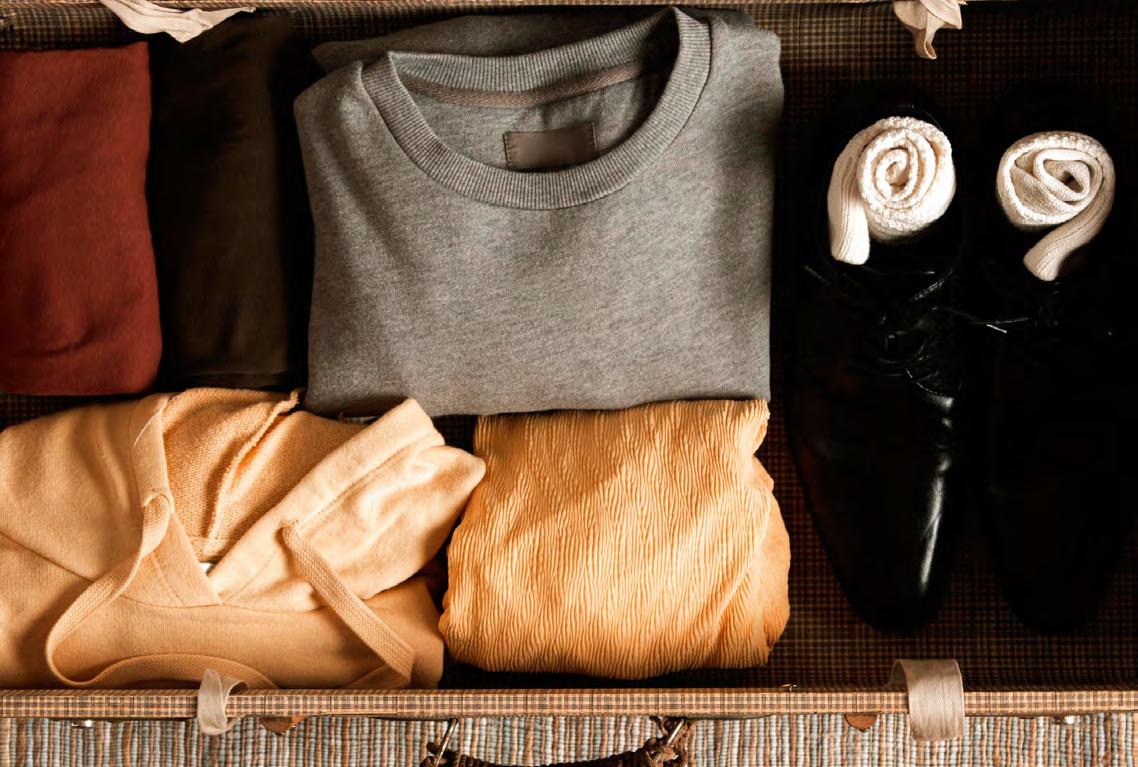
The Capsule Wardrobe is very closely linked to minimalism, however, the wardrobe itself does not need to consist of bland or basic clothing items or accessories. This is where staple wardrobe items come in; typically, people will tell you to keep your Capsule Wardrobe neutral both in colour and in styles. This can create a barrier of entry for people who might have favourite t-shirts or some really fun pairs of cargo pants but are less likely to own a wool coat, a pair of slacks or multiple blazers. Staple Wardrobe items do not need to fit the description of a timeless classic, they only need to be something that you can like and can wear in many different ways.

Many guides for creating a Capsule Wardrobe are designed for young professionals and primarily for women. Yet, many more people have more clothes than they can wear and could use a method to organize their wardrobe.
How to Build A Functional Wardrobe
The next question is where do you start? This process will obviously be different for everyone and my best advice is to be patient with yourself. Grab yourself your favourite snack and set aside a good chunk of time to dedicate to your decluttering process.
1. Take out your favourite things first. It’s nice to start easy, so grab out your favourite clothes or accessories and set them aside, this can also help you to think about what you wear most regularly.
2. Sort what’s left. Getting everything you own into categories allows you to judge potential gaps in your wardrobe as well as making it easier to let go of things that you have a lot of.
3. What kinds of outfits do you need to have available? This is where a lot of the online guides are limited. You need to evaluate your personal style and choose your wardrobe to suit that style. I would recommend some functional choices such as an interview-appropriate outfit, outfits for different seasons and something you could wear to a dinner dance. Other than that, it’s up to you!
4. You don’t need to cut down every category. If you have an extensive t-shirt collection, I would tell you to keep it! If you like to rotate between 5 different pairs of your favourite shoes, that’s amazing! Cut down on categories that you don’t find yourself wearing all of the items from, and allow yourself to hold onto things that you love.
5. If you can’t let go of things right away, put them away. Try putting away the clothes that you don’t need in your wardrobe and set a reminder to check on them in 3 months. If you haven’t touched those items in that time, it becomes easier to let them go instead of forcing yourself to get rid of things immediately after doing the work of sorting through all of your clothes.
These are not absolute rules and I would encourage you to play around with what organising your own space looks like for you. I think that the idea of a Capsule Wardrobe is interesting because it seeks to solve the problem of variety within your style while minimising the amount of clothing you need to own. If another way of curating your clothing works better for you, I hope you try it out! There is no right way to organise your space or to express yourself.
How to Get Ready in 15 Minutes and Not Look Like Crap
Now that you’ve sorted your wardrobe, you can maximise your efficiency in getting ready in the morning (also, coincidentally increasing your hours of sleep).
Try laying out your clothes the night before. This cuts down on time digging through drawers or looking for something specific and instead allows you to grab something extra (a hat, a belt, a scarf, etc) to pull your outfit together.
Accessorising is actually useful in tying an outfit together. While you are sorting through your clothes, think about the accessories you like to wear and how they will work with your outfits. If you’re feeling fancy, you can think about colour coordination and getting accessories that work with multiple different colours within your wardrobe.
Putting time and effort into organising your clothes and accessories can allow you to better express yourself. There is no right way to do any of this and I want to encourage you to explore your own personal style throughout your time in university and beyond.


The ways we painted our words unspoken
Anoushka Paul
Words, we meet again. A breath of silence, syllables left unspoken, We wear convictions like borrowed robes, We reach across the void with gestures that crumble, Speaking in echoes neither of us can translate. We feign a cry for causes we claim, Often deceived by echoes loud from the hollows.
You say it’s patience that will heal what’s broken, And I see your smile falter like a veiled setting sun, Fading behind mountains of things you never said, I argue that waiting often turns wounds into scars, When time is no ally to those who linger, When each unspoken thought hardens into distance, A brittle echo that shatters before it’s heard.
You say it’s space we need to find what we’ve lost, And I hear your voice drift like a leaf in autumn, Falling between us with dying promises of spring, I argue that distance only deepens the gaping chasm, When hearts grow colder with each measured step apart, When the silence stretches long enough and absence turns to comfort, A growing doubt that consumes whatever was left of light.
You say it’s kindness to let the sleeping homeless lie, And I watch your hand hesitate, frozen in mid-air, A bridge that almost touches but never quite crosses, I argue that truth is kinder than negligence and delay, When pretending not to see leaves us blind to each other, When peace built on pretense crumbles to unrest, A fleeting comfort that costs more than what we can afford.
You say it’s history that gives the present its worth, And I watch your eyes glaze over like a window, Reflecting only what lies not ahead but behind, I argue what worth staying stuck in time is, When the clock is indifferent to our reluctance, When today misunderstood is just tomorrow’s nothingness, A vague memory of words left hanging in the air.
Words, we meet again, but only as ghosts, Drifting between what is meant and what is said, A bridge left incomplete, a love left unspoken, The silence a language we’ve mastered too well, Leaving us both alone, though never quite apart, As if evasion is the only thread that keeps us tied.

Style and Sprezzatura
Sophia Hill
In 1528, the Italian Count Baldesar Castiglione wrote II Cortegiano, known in English as The Courtier or The Book of the Courtier, which describes the characteristics of the ideal courtier through his research and conversations with those attending the court of the duke Urbino. Within his book, he defines the word “sprezzatura;” a kind of seemingly effortless gracefulness that the successful courtiers embodied. Sprezzatura went on to influence art, literature, and fashion over the following centuries, and its influence can still be seen today, where looking back we see that sprezzatura motivates fashion trends, but also defines style.

The idea of appearing graceful and effortless comes from the historical context in which the idea of sprezzatura was created. Il Cortegiano was written towards the beginning of the European Renaissance, where power at court shifted from a noble’s military strength, as it was in the Middle Ages, to their social strength, due to the centralization of power at royal courts (as opposed to power spread out among the different houses of nobility). The goal of social power meant that courtiers had to display their status and wealth through their appearance, rather than their victories in battle.
In order to demonstrate magnificence and power at court, courtiers and monarchs used their clothing. In this period, and onward, men and women wore more voluminous and structured garments than previous eras. For example, women wore wider skirts which allowed them to physically take up more space and keep people at a distance, especially in male-dominated spaces, which was the case for the English Queen Elizabeth I. Elizabeth I was also associated with the oldest surviving garment in England that we would now call a corset, a type of garment characterised by the use of whalebone in its structure. This structure, while supporting the bust, also assisted in maintaining the posture of the wearer, projecting the gracefulness and confidence of the courtier embodying sprezzatura. Foundational garments for creating a more imposing figure and supporting the posture continued to be a staple of women’s and men’s fashion for over 300 years following the publication of Il Cortegiano, which demonstrates sprezzatura’s enduring influence on style trends.

After the beginning of the twentieth century, clothing styles changed to reflect changes in society since the days of hoop skirts and corsets. Though we do not have the same structured garments today as we did in the past, the influence of their origins is still with us. 1980s fashion is known for the striking silhouette of shoulder pads, and today there is a resurgence in garments that take inspiration from corsets and stays. Though it does in fact take a lot of effort, appearing effortlessly polished and graceful is still a display of confidence and authority, regardless of the style of one’s clothing.
Sprezzatura demonstrates that style is not necessarily what you wear, but how you wear it. Whether you are wearing a 16th century court gown or engineering coveralls today, wearing something with style comes from the confidence you project to have in it and yourself, even if you have to fake it ‘til
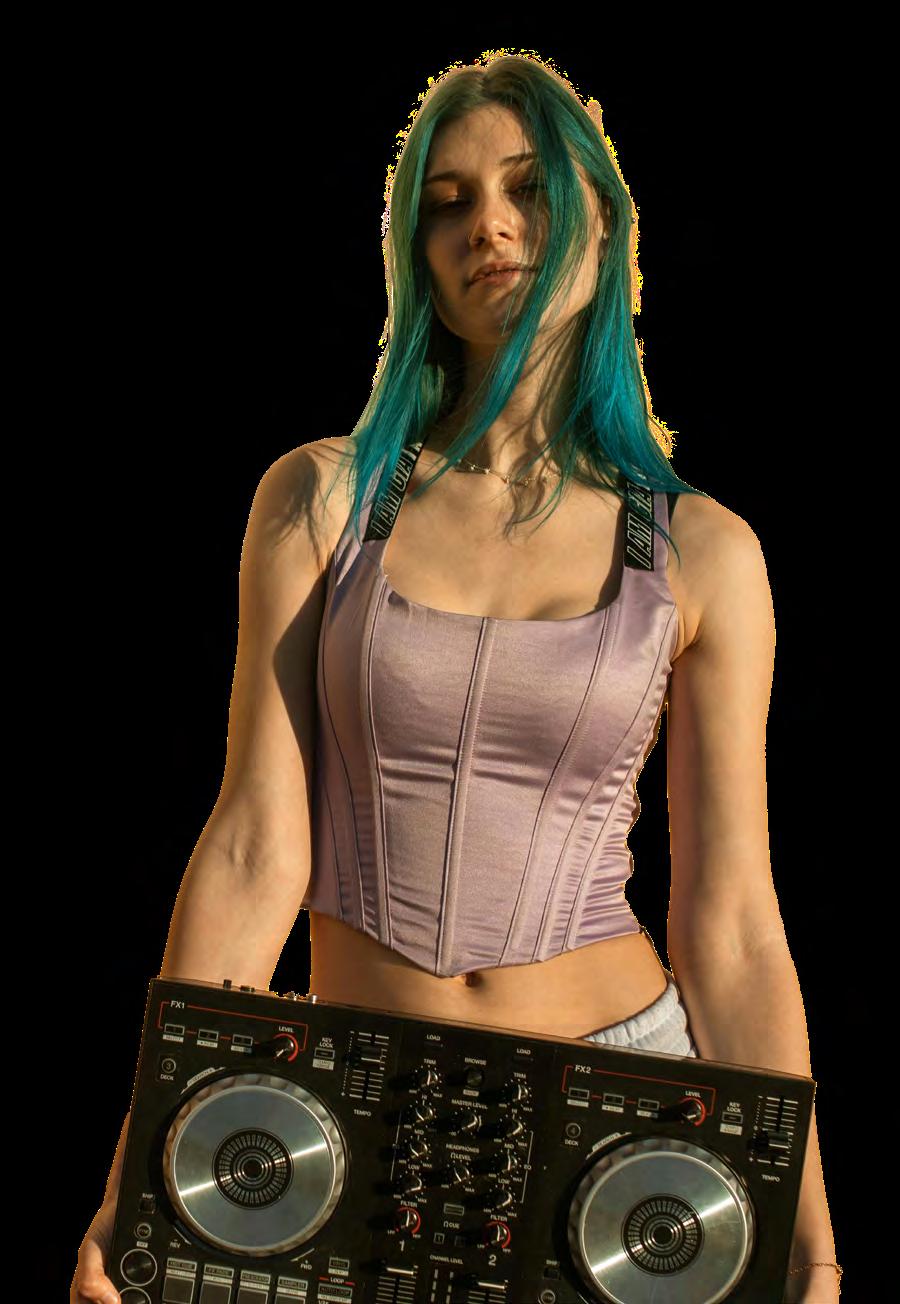
Alternatively, you can forgo sprezzatura entirely and demonstrate your power and confidence through your proficiency at the
History Lessons with Dr. Sarah Bendall. “Dress Historian explains the difference between Bodies and Stays | 16th and 17th-Century ‘Corsetry’”. Youtube. December 29, 2023.
Norton Anthology of English Literature, 8th Edition, Volume 1, W.W. Norton & Company, Inc., 2005, pp. 644.
Bendall, Sarah. Shaping Femininity: Foundation Garments, the Body and Women in Early Modern England, Bloomsbury, 2022, pp.58-61.
In This Issue


Charlie Therence
Iva Guo
Christina
Pizzonia
Navin Vanderwert
Tobin Zheng
Kaija
